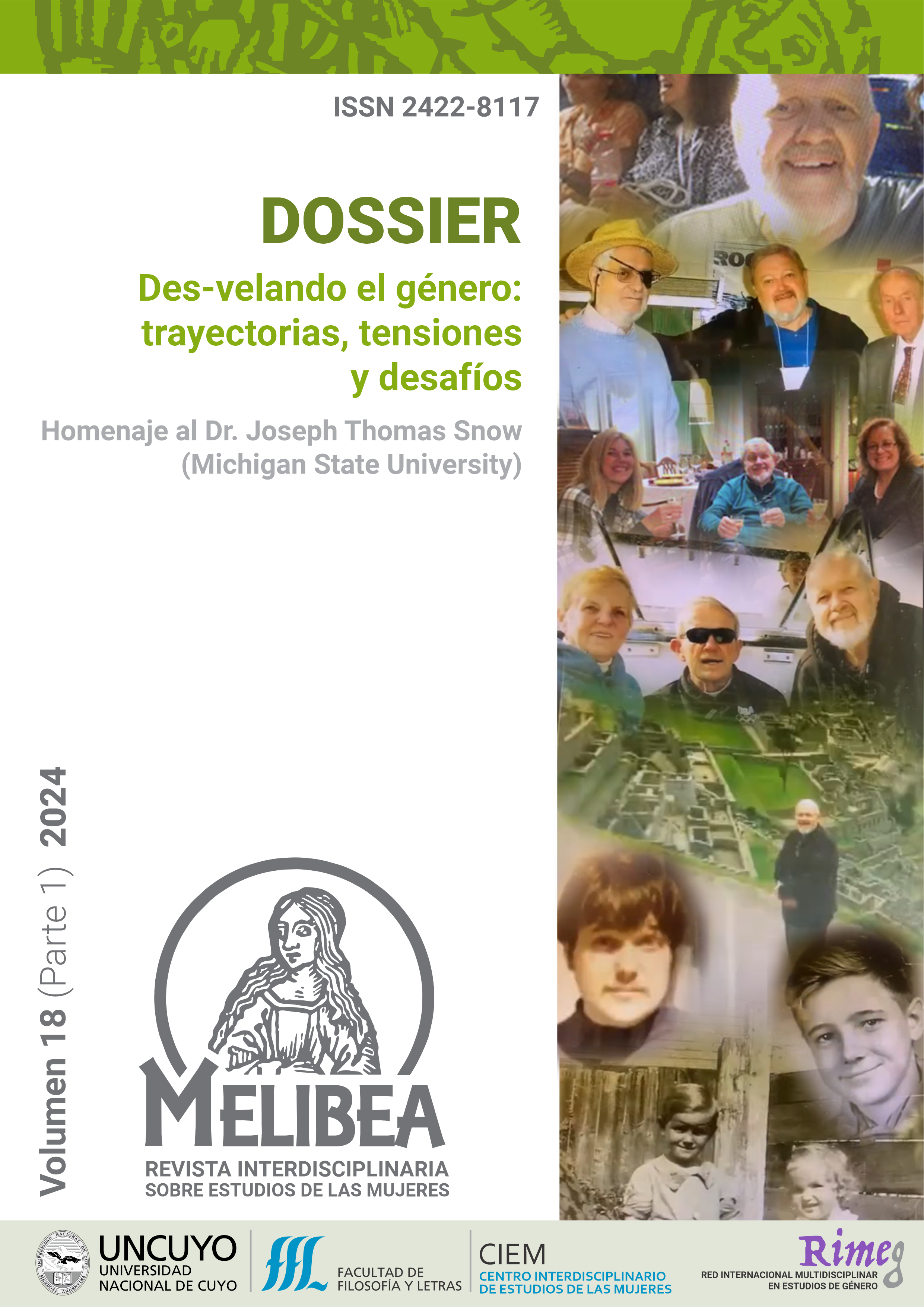Violencia contra las mujeres en la conquista timúrida (s. XIV y XV). El relato devastador del cronista Arabshah
Palabras clave:
Tamorlán, Mujeres, Arabshah, Crónica, S. XIV y XVResumen
Ahmad b. Muhammad Ibn 'Arabshah (1392-1450) escribió Las maravillas del destino de las conquistas de Tamorlán, biografía de este viajero árabe finalizada en Damasco el 12 de agosto de 1435. La obra de carácter eminentemente crítico a la gestión y conquistas de Tamorlán es una de las fuentes más elocuentes para el abordaje tanto de la mujer nómade de su propio clan como de las representantes de los pueblos dominados. Mujeres de todas las comunidades sojuzgadas, sobrevivientes de las masacres, fueron deportadas para realizar trabajos agrícolas y movilizadas a territorios lejanos separadas indefinidamente de sus familias. Las representantes de los linajes nobles garantizaron con sus vidas los pactos alcanzados y sirvieron para otorgar estirpe a las bandas de guerreros sin prestigio ni nobleza. El objetivo de este trabajo es enumerar los recursos cronísticos que utiliza el autor árabe para exponer las atrocidades cometidas contra las mujeres. En primer término, el relato de las “maravillas” de la avanzada timúrida, secuencia de actos de fuerza extrema que sorprendieron por el salvajismo y devastación. Y, en segundo lugar, la concatenación de hechos políticos que dieron lugar a la red de poder que se crea en torno a las mujeres de los territorios arrasados. La hipótesis primara es que Arabshah utiliza los mismos ejes cronísticos que sus contemporáneos pro-timúridas, el militar y el político, pero con un signo opuesto, considerando el rol femenino en este período de transiciones.
Citas
Ahmad b. Muhammad Ibn 'Arabshah. (1936). Tamerlane or Timur the Great Amir (Trad. J. H. Sanders). Vol. I y II. Luzac & Co.
Arbabzadah, N. (2017). Women and Religious Patronage in the Timurid Empire. En N. Green (Ed.), Afghanistan's Islam. From Conversion to the Taliban (pp. 56-70). University of California Press. https://ixtheo.de/Record/1741831946
Béguelin-Argimón, V. (2004). Lo maravilloso en tres relatos de viajeros castellanos del siglo XV. En Relato de viaje y Literaturas hispánicas (pp. 87-99). Visor. Biblioteca filológica hispana. https://www.cervantesvirtual.com/obra/lo-maravilloso-en-tres-relatos-de-viajeros-castellanos-del-siglo-xv/
Beltrán Llavador, R. (2021). La fiesta de los ahorcados: paisajes de degradación, injusticia y crueldad en la corte de Samarcanda (Embajada a Tamorlán). En V. Béguelin-Argimón (Ed.), Viajes hacia Oriente en el Mundo Hispánico durante el Medioevo y la Modernidad. Retórica, textos, contextos (pp. 49-91). Visor Libros.
Binbas, Í. E. (2016). Intellectual Networks in Timurid Iran: Sharaf al-Dīn ‘Alī Yazdī and the Islamicate Republic of Letters. Cambridge, Cambridge University Press. https://www.academia.edu/25755987/Intellectual_Networks_in_Timurid_Iran_Sharaf_al_Din_Ali_Yazdi_and_the_Islamicate_Republic_of_Letters
Broadbridge, A. F. (2018). Women and the Making of the Mongol Empire. Cambridge University Press.
Carbó, L. (2019). La corte femenina de Tamorlán. Sensorialidad y poder desde la perspectiva de Ruy González de Clavijo (1403-1406). En G. Rodríguez y G. Coronado Schwindt (Orgs.), Mirabilia, Senses and sensibilities in classical and medieval worlds, 29(2), 144-175. https://dialnet.unirioja.es/descarga/articulo/7228826.pdf
Carbó, L. (2019b). Los espacios femeninos tártaros en diálogo con la embajada castellana (1403-1406). En L. Vázquez Lorda (Comp.), Actas XIV Jornadas Nacionales de Historia de las Mujeres- IX Congreso Iberoamericano de Estudios de Género (29 de julio-1 de agosto 2019). Mar del Plata, UNMdP, 1009-1021. ISBN: 978-987-544-939-8. https://drive.google.com/file/d/1bGM1iPdQ1T1ceSmCz44ijif7ZH2Qfp4i/view
Carbó, L. y Rigueiro García, J. (2022). Las mujeres de la corte timúrida del siglo XV. Un estudio transversal entre palabras e imágenes. De Medio Aevo, 11(1), 41-64. https://revistas.ucm.es/index.php/DMAE/article/view/79356/4564456560104
Carrizo Rueda, S. (1992). Tradiciones tópicas y propósitos de objetividad en la embajada a Tamorlán.Revista de Literatura Medieval, IV, 79-86. https://ebuah.uah.es/dspace/handle/10017/7909?show=full
Daly, K. M. (2012). Here there be no dragons: maravilla in two fifteenth-century Spanish libros de viajes. Notandum, 29, 25-34. CEMOrOC, Feusp/Universidade do Porto.
García Espada, A. (2017). El Imperio Mongol. Síntesis.
Garrosa Resina, A. (1985). La tradición de animales fantásticos y monstruos en la literatura medieval española. Castilla: Estudios de Literatura, 9-10, 77-102.
González de Clavijo, R. (1782). Vida y Hazañas del Gran Tamorlán. Antonio de Sancha ed.
González de Clavijo, R. (1943). Embajada a Tamorlán (Ed. crítica de Francisco López Estrada). CSIC.
Krauss-Sánchez, H. R. (2016). Ibn ʿArabshāh. En G. Dunphy y C. Bratu (Eds.), Encyclopedia of the Medieval Chronicle. Brill. http://dx.doi.org/10.1163/2213-2139_emc_SIM_01753
Melville, C. (2019). Visualising Tamerlane: History and its Image. Iran Journal of the British Institute of Persian Studies, 57(1), 83-106. https://doi.org/10.1080/05786967.2019.1578543
Monfared, M. F. (2008). Sharaf Al-Dīn 'Alī Yazdī: Historian and Mathematician. Iranian Studies, 41(4), 537-547. www.jstor.org/stable/25597488
Monsalvo Antón, J. M. (2021). "En tiempo de los Reyes donde yo vengo" Usos del pasado y legitimación monárquica (del Reino de Asturias a los Trastámara). Universidad de Murcia. ISBN 9788417865832.
Moranvillé, H. (1894). Mémoire sur Tamerlan et sa cour par un dominicain, en 1403. Bibliothèque de l'école des Chartes, 55, 433-464. https://www.persee.fr/doc/bec_0373-6237_1894_num_55_1_447782
Natif, M. (2002). The Zafarnama [Book of Conquest] of Sultan Husayn Mirza. Papers of the Index of Christian Art, 211-228. Princeton University Press. https://www.academia.edu/23289107/_The_Zafarnama_of_Sultan_Husayn_Mirza._
Pérez Priego, M. Á. (1984). Estudio Literario de los libros de viajes medievales. Epos, Revista de Filología, (1), 217-239.
Yazdi, Sharaf al-din Ali (1723). The History of Timur-Bec, known by the name of Tamerlain the Great, Emperor of the Moguls and Tartars: being an Historical Journal of his Conquests in Asia and Europe (Vol. I). Bartholomew-Close. https://archive.org/details/39020024846878-thehistoryoftim/page/n565/mode/1up?view=theater
Yazdi, Sharaf al-din Ali (1723). The History of Timur-Bec, known by the name of Tamerlain the Great, Emperor of the Moguls and Tartars: being an Historical Journal of his Conquests in Asia and Europe (Vol. II). Bartholomew-Close. https://archive.org/details/39020024846811-thehistoryoftim/page/n390/mode/1up?view=theater
Ziyadullayevich, U. S. (2018). Amir Temur In Arabic Sources of Comparative Philosophy Analysis. International Journal on Integrated Education, 1(I), 40-42. https://www.neliti.com/publications/334032/amirtemur-in-arabic-sources-of-comparative-philosophy-analysis
Descargas
Publicado
Cómo citar
Número
Sección
Licencia

Esta obra está bajo una licencia internacional Creative Commons Atribución-NoComercial 4.0.
Esta obra está bajo una Licencia Creative Commons Atribución-NoComercial 4.0 Internacional.
Los/as autores/as que publican en esta revista están de acuerdo con los siguientes términos:
1. Los/as autores conservan los derechos de autor y garantizan a la revista el derecho de ser la primera publicaci´´ón del trabajo bajo una licencia Creative Commons Atribución-NoComercial 4.0 Internacional. Por esto pueden compartir el trabajo con la referencia explícita de la publicación original en esta revista.
2. Revista Melibea permite y anima a los autores a difundir la publicación realizada electrónicamente, a través de su enlace y/o de la versión postprint del archivo descargado de forma independiente.
















